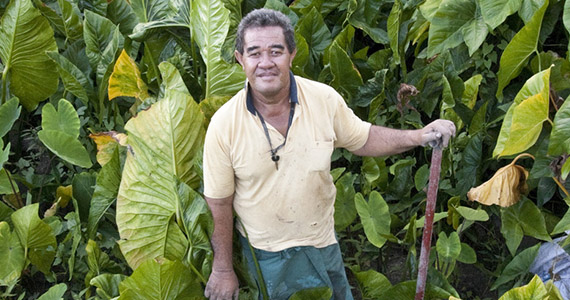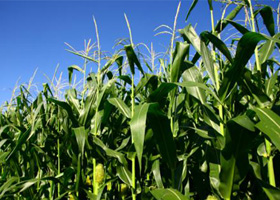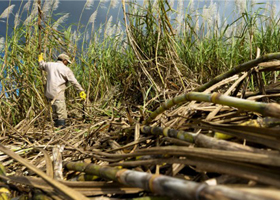
Image credit: Rodney Dekker/OxfamAUS
The paradox in our broken food system
Author | Oxfam Australia

Yet, one in eight people on our planet go to bed hungry each night. So why does hunger exist in a world with enough food for all?
Because hunger — along with obscene levels of waste and appalling environmental degradation — are by-products of our broken food system. A system under further pressure from extreme weather events, rising food prices and failing production.
Who are the hungry?
Understanding who is hungry illustrates the abject failure of our current food system. It is surprising to discover that 80% of the world’s hungry people are directly involved in food production. (2)
They tend animals. They cultivate crops on their own small plots of land, or on land rented from others. In some cases, they also supplement their diet with food from forests and the sea.
The hungry are small-scale food producers. Paradoxically, they are surrounded by the means to produce and collect food, yet they miss out. Why?
The reason why small-scale food producers go hungry is that they have been pushed aside by governments and companies for decades.
Even government aid to small-scale food producers declined by up to 77% in real terms between 1996 and 2003. (3)
Small-scale food producers have been pushed aside because of three enduring myths:
MYTH 1: small-scale food producers are unproductive
Reality: these producers often have low yields because they don’t have access to the resources needed to increase production. For example, small farms in Africa use tiny amounts of fertiliser, about one-eighteenth of farms elsewhere.(4) In comparison, many large-scale farmers receive financial assistance through lavish subsidies. As an Australian agriculture minister once said, “Cows in the European Union receive greater subsidies than these people.”(5)
MYTH 2: small-scale food producers won’t adapt
Reality: producers living in poverty don’t choose to cling to basic tools and farming practices as their preferred option. They rarely receive support from their governments or the private sector, and are often forced to leave prime agricultural land and fishing areas. Despite this, small-scale food producers are often at the forefront of agricultural and ecological practice, such as developing improved seed varieties (6) and responding to changing weather patterns.
MYTH 3: small-scale farming is subsistence only
Reality: small-scale farmers in developing countries want to sell their excess produce. So why don’t they? Without access to basic storage or refrigeration, and with few transport options, at least one-third of all their food perishes before making it to market. (7)
Oxfam’s experience shows that small-scale food producers jump at the chance to cultivate and sell excess produce, but are hampered by a lack of the most basic infrastructure.
The land grab phenomenon
Rather than tackling these myths and supporting small-scale food producers, many governments in developing countries are pushing them off their land and offering it to foreign governments and large corporations at rock-bottom prices.
In 2009 alone, the World Bank estimated that foreign investors acquired long-term rights (for example, 99 year leases) for almost 110 million acres of farming land and water in developing countries. (8)
The result is that countries rich enough to invest in off-shore land are able to secure food for their own domestic consumption. But this comes at the cost of those in developing countries who have lost their land, contributing to food insecurity and increasing migration to urban slums. (9)
What can I do?
Movements to transform our broken food system have sprung up everywhere. From Australia to Bangladesh, people are working together to alter the way we produce, consume and even think about food. Oxfam wants to build on our ongoing work and help grow these movements to foster a consensus for change.
We are at a turning point. Join with us and be part of a future where everyone has enough to eat, always.
Please visit Oxfam Australia to find out more.
Oxfam Australia works to bring about positive change in the lives of people living in poverty. Oxfam’s GROW campaign is working to change the fact that almost 870 million people go to bed hungry every night, not because there isn’t enough food, but because of deep injustices in the global food system. Oxfam has contributed articles on Fair Trade and Food Security to the Foodwise website.
1 Reducing Poverty and Hunger, the Critical Role of Financing for Food, Agriculture, and Rural Development, Food and Agriculture Organization of the United Nations, International Fund for Agricultural Development, World Food Program, 2002.
2 Australian aid: Approach to food security, Australian Agency for International Development (AusAID), Canberra, 2006. Information based on figures from Food and Agriculture Organization of the United Nations, www.fao.org
3 Calculated from OECD DAC5 database “Official Bilateral Commitments by Sector”; includes forestry and fishing.
4 “A Special Report on Feeding the World”, The Economist, 24 February 2011.
5 Warren Truss, Former Australian Minister for Agriculture, Fisheries and Forestry, quoted in “World Food Day highlights the importance of food security”, media release, 15 October 2003. Accessed at http://pandora.nla.gov.au/pan/54888/20051219-0000/www.maff.gov.au/releases/03/03279wt.html
6 “High-yielding varieties of rice have been adopted on more than 200,000 hectares of farmland”, Rural Poverty Report, International Fund for Agricultural Development, 2011. Accessed at www.ifad.org/rpr2011/report/e/rpr2011.pdf
7 The Future of Food and Farming, Final Project Report – 4.4, Foresight, The Government Office for Science, London, 2011. Accessed at www.bis.gov.uk/foresight/our-work/projects/current-projects/global-food-and-farming-futures/reports-and-publications
8 Rising Global Interest in Farmland, World Bank, 2010.
9 “How not to think about land grabbing”, opinion piece by Olivier De Schutter, UN Special Rapporteur on the Right to Food, 12 January 2011.





